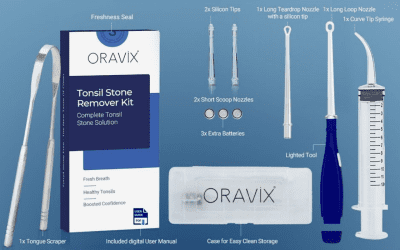Published on May 29, 2025
Tonsil stones can be frustrating. They cause bad breath and may make your throat feel sore. You might have tried gargling with salt water or homemade remedies like apple cider vinegar, but not all rinses work the same. Some may even do more harm than good.
That’s where tonsil stone rinses come in. These are special oral solutions designed to clean the deep folds (or crypts) in your tonsils where stones form. Dental experts recommend using a tonsil stone rinse with oxygenating ingredients like chlorine dioxide or stabilized hydrogen peroxide. These break down bacteria and sulfur compounds that cause stones and bad breath.
In this guide, we’ll explain:
- Which rinses are proven to help remove and prevent tonsil stones
- What ingredients to look for (and which to avoid)
- Step-by-step instructions on how to use rinses and tools the right way
- What dental experts recommend for lasting relief

How to Use a Tonsil Stone Rinse for Maximum Effectiveness
Tonsil stone rinses work best when used consistently, with the right ingredients, and with good technique. Here’s a step-by-step guide on how to use a tonsil stone rinse to get rid of tonsil stones efficiently:
1. Choose a rinse or mouthwash made for tonsil stones.
Look for ingredients like:
- Chlorine dioxide or stabilized hydrogen peroxide: break down odor-causing sulfur compounds. The U.S. Environmental Protection Agency (EPA) says chlorine dioxide is safe in drinking water as long as the amount stays below 0.8 milligrams per liter [1].
- Cetylpyridinium chloride (CPC) or zinc compounds: kill bacteria that contribute to stones
2. Gargle deeply, not just swish.
Take a mouthful of the rinse, tilt your head back, and gargle for 30–60 seconds. This helps the liquid reach the tonsil crypts, where debris and bacteria build up. Do not swallow the product.
“Gargling deeply and forcefully helps flush out small particles before they harden”.

A safety note:
If you’re using a rinse with active ingredients like stabilized hydrogen peroxide, it’s important to follow directions carefully. These products are safe when used as intended, but swallowing more than a small amount can be harmful [2]. If you or someone else has difficulty breathing or passes out, call 911 right away. For any other concerns, contact your local Poison Control center: 1-800-222-1222 in the US, or 1-844-764-7669 in Canada.
3. Rinse consistently, 1–2 times a day.
Use your rinse in the morning and at night for best results, especially if you’re prone to post-nasal drip or chronic stones.
4. Combine with good oral hygiene.
Rinsing works best when it’s part of your daily routine:
- Brush and floss regularly
- Use a tongue scraper daily to reduce extra bacteria and prevent future tonsil stones from forming
- Drink plenty of water to stay hydrated
- Consider using a nasal rinse to reduce mucus buildup.
“Nasal rinsing helps to remove the mucus in the mucosal layers and reduces your chances of getting tonsil stones in the first place.”
Bonus Tips: Use a Tool to Boost Rinse Effectiveness
To help rinse deeper into the tonsils, consider rinsing with a tool like the:
These tools help gently flush the rinse into the tonsil crypts, which may be hard to reach with gargling alone.
Here’s the best way to use them based on our user manuals:
Option 1: Use the Oravix Tonsil Stone Vacuum
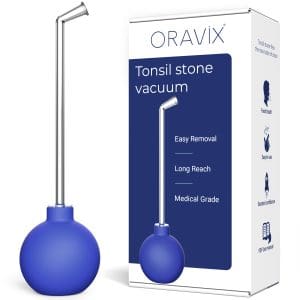
How to use it:
1. Gargle to loosen debris:
Gargle gently with luke warm water. This helps loosen up your tonsil stones and prepares the area for flushing.

2. Fill the bulb with lukewarm, salty water.Then assemble the bulb and pipe with a slight twist to ensure a secure fit.

3. Flush your tonsils:
Stand in front of a mirror. Aim the pipe end at the tonsil crypts and squeeze the bulb gently to flush over the tonsils.

Option 2: Use the Oravix Tonsil Stone Removal Water Flosser
The Oravix Water Flosser uses targeted water pressure to flush out debris and is perfect for ongoing maintenance and for people with frequent stones or post-nasal drip.
How to use it:
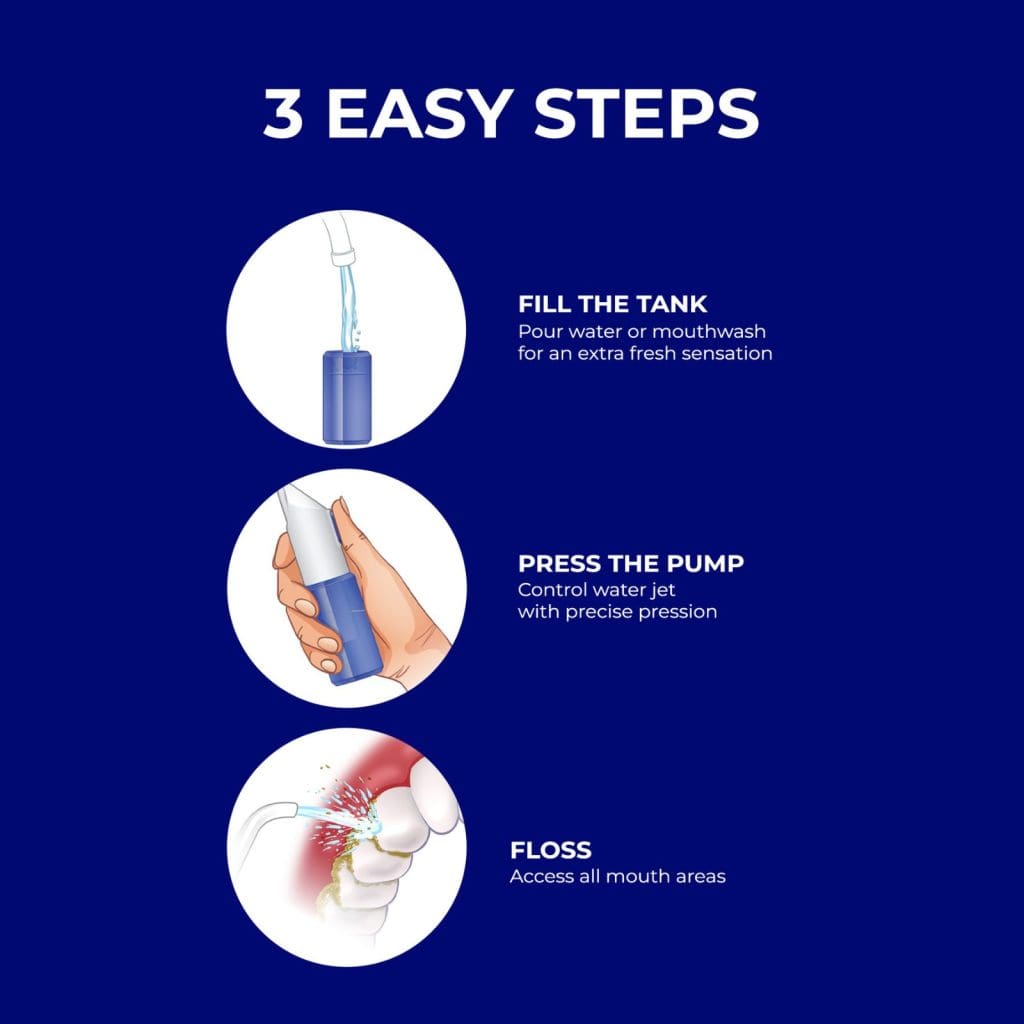
- Fill the tank with lukewarm water:
Turn the water tank clockwise to open and remove it from the base.
Fill it with lukewarm water up to the “MAX” line, then attach it back and turn counter-clockwise until it’s tight. - Prime the pump:
Press the pump button 2–3 times until a steady water stream comes out of the nozzle. - Flush your tonsils:
Hold the irrigator upright and place the nozzle against your tonsil crypts. Press the pump button to spray a gentle water stream directly onto the stones and flush them out.
If you happen to swallow a tonsil stone, there is nothing to worry about.
DIY vs. Professional Tonsil Rinses: What Works Best? (With Expert Tips)
Our quick answer:
- DIY rinses like saltwater, regular hydrogen peroxide, or apple cider vinegar can help with small tonsil stones, but they don’t clean deep. Doctors like Dr. José Valdés warn that using them too often or at full strength can irritate your throat or damage your teeth. You also have to mix them yourself each time.
- Professional tonsil rinses are made to be stronger and safer. Experts like Dr. Madhur Sharma say the best ones have oxygenating ingredients (like chlorine dioxide) that help break down bacteria and bad smells. They’re gentle, pH-balanced, and ready to use: just open and rinse.
If you want something that’s easy, safe, and works better: go with a professional rinse.
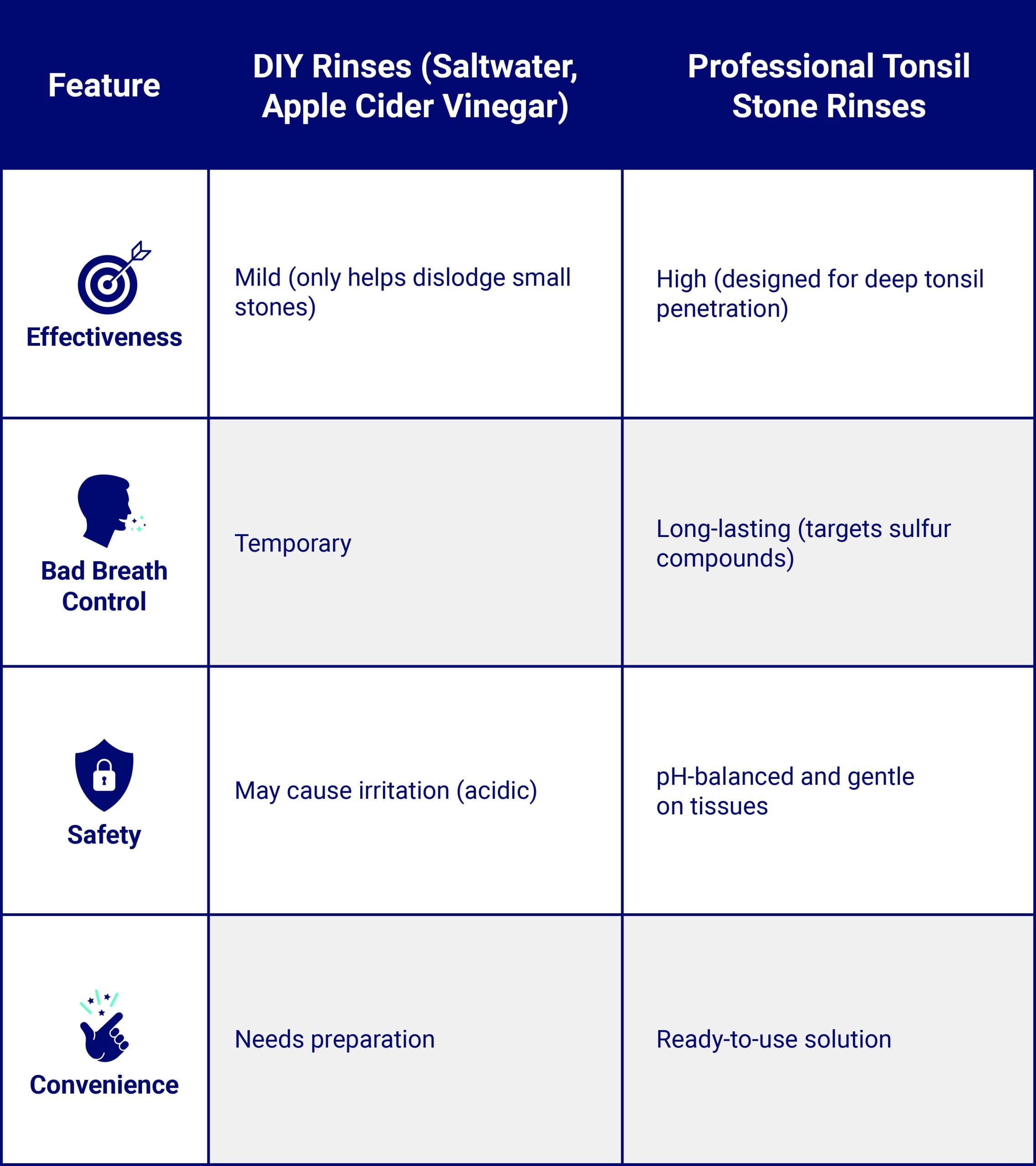
Is Salt Water Good for Tonsil Stones?
While it can offer temporary relief, experts agree salt water isn’t always strong enough to remove or prevent tonsil stones on its own.
It’s gentle and easy to make (mix a teaspoon of salt mixed with a cup of warm water), but salt water doesn’t clean deep enough into the tonsils, where stones actually form.
Professional rinses are made to clean deep into tonsil crypts, break down odor-causing bacteria, and prevent new stones from forming.
Bottom line: Salt water is helpful for mild relief. But if you want to stop tonsil stones from coming back, go with a rinse designed to treat them at the source.
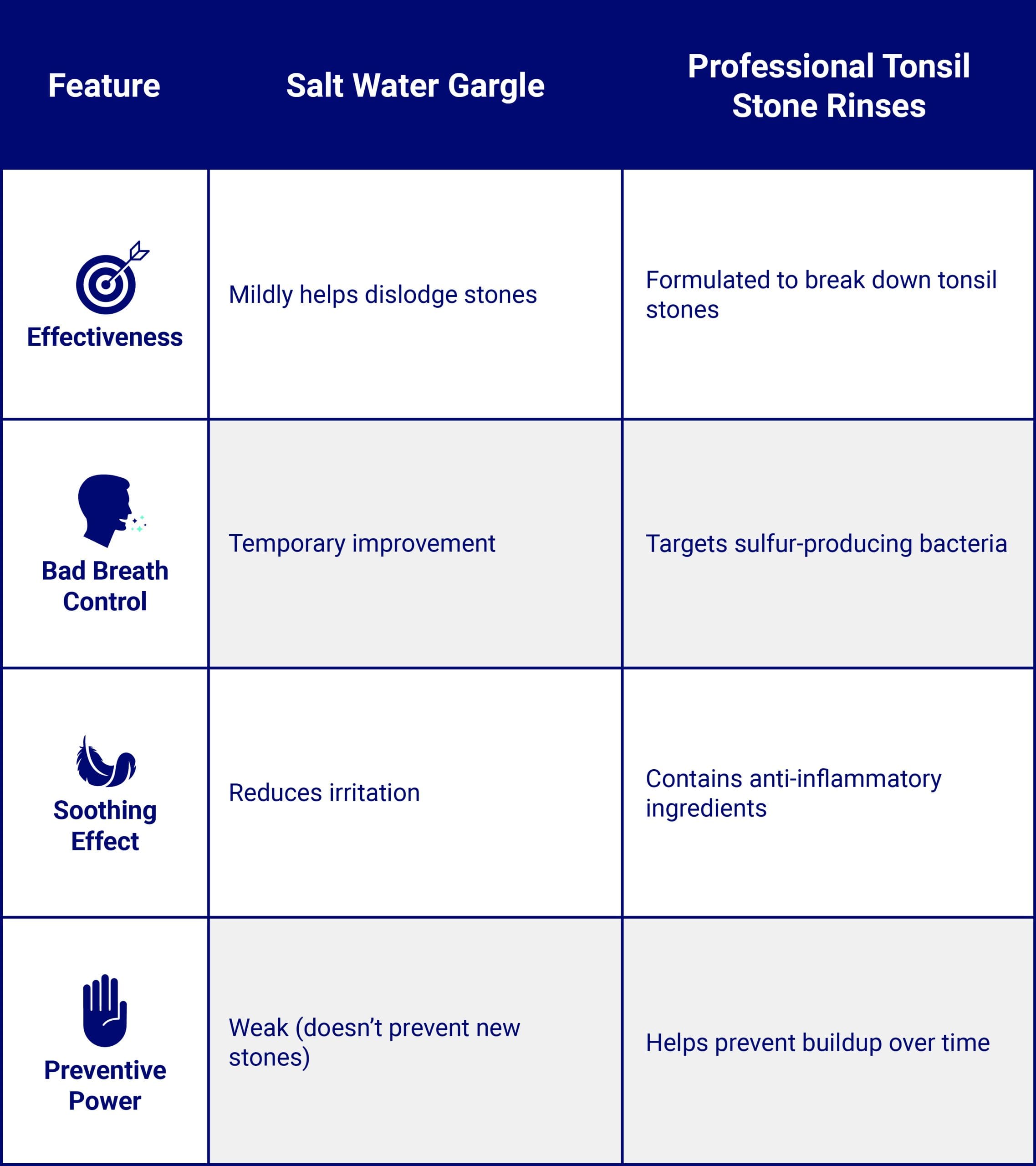
Does Apple Cider Vinegar Help with Tonsil Stones?

Apple cider vinegar (ACV) doesn’t really work for removing tonsil stones and it may do more harm than good when it’s not used properly. Many people try rinsing with apple cider vinegar (ACV) to get rid of tonsil stones as a natural fix, because:
- ACV is acidic, which means it might help break down tonsil stones slowly.
- ACV may kill some bacteria that cause bad breath [3].
But according to dental experts, this method can actually damage your mouth if used the wrong way:
- It’s very acidic. Experts like Dr. José Valdés and Dr. Madhur Sharma warn that it can wear down your tooth enamel and irritate your throat, especially if it’s not diluted.
- There’s no strong research showing that ACV can actually dissolve tonsil stones.
“Apple cider vinegar is acidic and erodes enamel over time. Dilute it and use it moderately if you do”, warns Dr. Valdés.
Why Regular (Non-stabilized) Hydrogen Peroxide Doesn’t Work for Tonsil Stones
Some people believe rinsing with regular, non-stabilized hydrogen peroxide can remove tonsil stones, but experts say it’s not the best choice.
That’s because regular hydrogen peroxide, while commonly used to disinfect wounds and kill germs, isn’t designed for deep tonsil care. It foams when it touches bacteria, which might make it seem like it’s working. But in reality, it doesn’t do much to break down the hardened debris that forms tonsil stones, and it can even irritate your throat or damage gum tissue if used the wrong way.
Problems with regular hydrogen peroxide rinses:
- It foams but doesn’t dissolve stones.
Tonsil stones are calcified, meaning they’re hard like tiny rocks. While hydrogen peroxide creates bubbles that can loosen soft debris, it can’t break down the hardened material that makes up a tonsil stone.
- It can irritate your throat or damage the gum tissue.
Using hydrogen peroxide too often or at a strong concentration can cause a burning or tingling feeling.
“Hydrogen peroxide must always be diluted, ideally to 3% or less, before use. In high concentrations, it can irritate your throat, and even lower concentrations may damage gum tissue or erode tooth enamel if used too often.”
— Dr. Vishala Patel and Dr. José Valdés
- It may upset the balance of good bacteria.
“ If used too often or in high concentrations, it can disrupt the balance of good and bad bacteria in the mouth”, says Dr Madhur Sharma.
By contrast, stabilized hydrogen peroxide, found in professional rinses, is a different story. This version is specially formulated to release oxygen slowly and safely. It’s gentler on soft tissues and more effective at deep cleaning the tonsil crypts without the harsh side effects. That’s why many store-bought tonsil stone rinses recommended by dental professionals include it.
Which Tonsil Stone Rinses Should You Use Instead? What the Experts Recommend
Choose Rinses with Oxygenating Ingredients
“Instead, choose rinses with oxygenating agents – they’re safer and more effective for preventing tonsil stones,” says Dr. Sharma.
- Use a pH-balanced rinse with chlorine dioxide or stabilized hydrogen peroxide. These oxygenating ingredients help break down sulfur compounds and clean deep into tonsil crypts, where stones form.
- Zinc-based rinses also help neutralize odours and slow bacterial activity, according to Dr. Sharma.
- If you have a sensitive throat, try a gentle saline or herbal-based rinse instead.
Support with Antibacterial Agents
Rinses with cetylpyridinium chloride (CPC) or essential oils like thymol and eucalyptol can help lower bacteria levels. However, Dr. Sharma and Dr. Patel explain these don’t always go deep enough into the tonsils to prevent stones on their own.
Be Careful with DIY Options
While hydrogen peroxide and apple cider vinegar are popular online, they aren’t risk-free.
- Hydrogen peroxide can irritate your throat if it’s too strong or used too often
- Apple cider vinegar is acidic and may damage tooth enamel
Dr. Valdés says if you use them, always dilute them and use them only once in a while, not daily.
Know When to See a Doctor
For large, painful or recurrent stones that cause persistent bad breath or difficulty swallowing, particularly when rinses and at-home remedies don’t help, a doctor should always be seen immediately.
Dr. Patel explains that ENT specialists use special instruments, like curettes, suction devices or water irrigation tools, to safely remove tonsil stones. For recurrent or deeply embedded stones, they may recommend laser cryptolysis or even tonsillectomy in severe cases.
Nasal Rinses Help Too
Mucus from post-nasal drip carries bacteria into the tonsils and helps stones form. All our experts agree: doing saline nasal rinses can help stop mucus buildup and prevent stones.
Tonsil Stone Rinse vs. Mouthwash: What’s the Difference?

Mouthwash and tonsil stone rinses aren’t the same. While regular mouthwash can make your breath smell nice and help prevent plaque, gingivitis and cavities [4], it usually doesn’t help with tonsil stones. To really clean your tonsils and stop stones from coming back, you need a solution made just for that job.
What Mouthwash Does (and Doesn’t Do)
“Most mouthwashes bought in stores are made to fight plaque and freshen breath. But they often don’t go deep enough to clean where tonsil stones form”, says Dr. Madhur Sharma. Many also contain alcohol, which can dry out your mouth and make things worse, explains Dr. José Valdés.
Why Tonsil Stone Rinses Work Better
Tonsil stone rinses are made with special ingredients like:
- Chlorine dioxide
- Stabilized hydrogen peroxide
- Cetylpyridinium chloride (CPC)
- Essential oils (like thymol or eucalyptol)
These ingredients help:
- Break down sulfur compounds that cause bad breath
- Kill the bacteria hiding deep in the tonsil crypts
- Loosen up food, mucus, and debris before they can harden into stones
“Oxygenating rinses like chlorine dioxide and stabilized peroxide clean deeper and help prevent stones,” explains Dr. Valdés.
“Antibacterial agents like CPC or essential oils can help too, but oxygenating rinses are usually more effective,” adds Dr. Sharma.
Quick Comparison
| Regular Mouthwash | Tonsil Stone Rinse | |
| Freshens breath | ✔ Yes, but only for a short time | ✔ Yes, longer-lasting (targets sulfur compounds) |
| Cleans deep in tonsils | ❌ No | ✔ Yes (with chlorine dioxide or hydrogen peroxide) |
| Prevents stones | ❌ No | ✔ Yes (removes bacteria and debris from tonsil crypts) |
| Safe for daily use | ❌ Not always (many contain alcohol) | ✔ Yes (gentle, alcohol-free formulas with CPC or essential oils) |
Bottom line: If you want to get rid of stones and stop them from coming back, choose a rinse with oxygenating ingredients like chlorine dioxide or stabilized hydrogen peroxide, and mild antibacterial agents like CPC or essential oils.
Best Practices to Prevent Tonsil Stones from Coming Back
Once you’ve removed tonsil stones, the next step is making sure they don’t come back. With the right habits and tools, you can keep your mouth clean and your tonsils clear.
1. Keep Up With Daily Oral Hygiene
Brush your teeth twice a day, floss daily, and don’t forget to scrape your tongue as recommended by the National Institutes of Health [5]. A tongue scraper helps remove bacteria and food debris, two of the biggest causes of tonsil stones.
2. Stay Hydrated and Watch Your Diet
Drink plenty of water to keep your mouth moist and help flush bacteria away. Try to cut down on sugar and dairy, especially before bed. These can increase mucus and bacterial buildup.
3. Use a Tonsil Stone Rinse Every Day
Rinsing with a specialized tonsil stone rinse helps remove bacteria, food particles, and mucus before they harden into stones.
4. Add a Nasal Rinse to Your Routine
Post-nasal drip is a common cause of tonsil stones. Doing a saline nasal rinse once a day can help clear mucus and reduce the chances of buildup in your throat.
5. For Chronic Cases, Add an Antimicrobial Spray
If you get tonsil stones often, consider using an antibacterial mouth spray after rinsing. It can help kill leftover germs and keep your tonsils cleaner between rinses.
6. Use a Water Flosser to Clean Deep into Tonsil Crypts
A water flosser helps flush out leftover food, mucus, and bacteria from the deep pockets in your tonsils (called crypts) where stones often form. A 2024 research review found that water flossers work really well at removing food and plaque, just like regular floss [5]. They’re especially helpful for people who have braces, dental implants, or trouble using their hands [6]. That makes them a great tool for cleaning around your tonsils too.
Using the Oravix Tonsil Stone Removal Water Flosser daily can help prevent buildup that brushing and rinsing can’t reach.
FAQ: Answering Common Tonsil Stone Rinse Questions
What is the best mouthwash for tonsil stones?
The best mouthwash for tonsil stones isn’t a regular one—it’s a special rinse made with oxygenating and antibacterial ingredients.
Look for rinses that include:
- Chlorine dioxide or stabilized hydrogen peroxide (to break down debris and sulfur compounds)
- Cetylpyridinium chloride (CPC) or zinc compounds (to kill bacteria)
“Oxygenating agents are usually more effective at preventing tonsil stones than antibacterial ingredients alone.” — Dr. José Valdés
Does salt water stop tonsil stones?
Not really. Salt water is great for soothing a sore throat and reducing inflammation. It can help loosen small stones, but it’s not strong enough to prevent new ones from forming.
“Salt water helps reduce irritation, but it doesn’t reach the deep pockets where stones form.” — Dr. Madhur Sharma
Can rinsing the nose help prevent tonsil stones?
Yes, using a saline nasal rinse helps clear mucus from your nose and throat, making tonsil stones less likely. Tonsil stones often form when mucus from post-nasal drip sticks to the tonsils and traps bacteria.
“Nasal rinsing reduces the chances of getting tonsil stones by clearing out mucus.” — Dr. Valdés
What is the drug for tonsil stone rinses?
Most tonsil stone rinses aren’t drugs—but they do contain active ingredients that help fight bacteria and clean your tonsils.
Common ones include:
- Chlorine dioxide – breaks down sulfur compounds
- Zinc compounds – help neutralize odor-causing bacteria
- Stabilized hydrogen peroxide – gently loosens debris
These ingredients make rinses more effective than regular mouthwash.
Final Thoughts: Why the Right Tonsil Stone Rinse Matters
The right tonsil stone rinse is the one that’s designed to clean deep into your tonsils and fight off the bacteria and debris that cause stones in the first place.
To prevent tonsil stones from returning, follow these good practices recommended by oral health experts:
- Use a tonsil stone rinse with oxygenating ingredients like chlorine dioxide or stabilized hydrogen peroxide
- Gargle deeply for at least 30–60 seconds, don’t just swish
- Rinse 1–2 times daily, especially if you have post-nasal drip
- Scrape your tongue daily to remove extra bacteria
- Consider a nasal rinse to reduce mucus and keep your tonsils clear
- Try using a tonsil stone vacuum or tonsil stone water flosser to help your rinse go deeper
This article offers general oral health info and isn’t a substitute for professional advice. Always consult your dentist or healthcare provider with any medical questions.
References
- Agency for Toxic Substances and Disease Registry (ATSDR). Toxicological Profile for Chlorine Dioxide and Chlorite. U.S. Department of Health and Human Services. September 2004. Accessed May 15, 2025. https://www.atsdr.cdc.gov/ToxProfiles/tp160-c1-b.pdf
- WebMD. (n.d.). Hydrogen peroxide mucous membrane (topical): Uses, side effects, interactions, pictures, warnings & dosing. WebMD. Retrieved May 15, 2025, from https://www.webmd.com/drugs/2/drug-4570/hydrogen-peroxide-mucous-membrane/details
- Gopal, J., Anthonydhason, V., Muthu, M., Gansukh, E., Jung, S., Chul, S., & Iyyakkannu, S. (2019). Authenticating apple cider vinegar’s home remedy claims: antibacterial, antifungal, antiviral properties and cytotoxicity aspect. Natural product research, 33(6), 906–910. https://doi.org/10.1080/14786419.2017.1413567
- Boyle, P., Koechlin, A., & Autier, P. (2014). Mouthwash use and the prevention of plaque, gingivitis and caries. Oral diseases, 20 Suppl 1, 1–68. https://doi.org/10.1111/odi.12187
- National Institutes of Health (NIH) (2020, March 13). Taking Care of Your Teeth and Mouth. National Institute of Aging. Retrieved July 4, 2024, from https://www.nia.nih.gov/health/teeth-and-mouth/taking-care-your-teeth-and-mouth
- Guimarães Sampaio Trajano Dos Santos, P., Sampaio Garcia Leite, D., De Queiroz Marques Filho, E., Coelho de Ataíde Filho, A., Dias de Oliveira Antonino, M.A., Scavuzzi Carneiro Cunha, R., De Sá Rodrigues, V.M., Dos Santos Ferreira, G., Coelho Travassos, R.M., & Barreto Silva, L. (2024). Water Flosser versus Traditional Flosser: Which is More Effective at Removing Food Debris and Plaque? Brazilian Journal of Implantology and Health Sciences. https://doi.org/10.36557/2674-8169.2024v6n12p2598-2613

I’m a biomedical engineer turned content writer with over a decade of experience in the healthcare industry and a Master’s Degree in Biological Sciences. I’m passionate about transforming complex scientific research into accessible content to help readers make informed decisions about their health.


